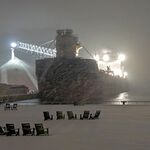If you look at the work that has been completed or initiated since 2015, it has been very much distributed across the various corridors. Sprinkled, as it seems.
I imagine that the one-at-a-time approach was not pursued as it would have been politically dangerous: it would have created winners and losers, and every municipality would have stood up and demanded to go first. The (only) benefit of the approach to date is that (if you believe the silly PR pronouncements) good things are happening, all over. (Except, so far, they aren't).
However if one cuts through the PR crap, the reality is that no one is seeing much forward progress yet, because no line has seen enough critical mass or sufficient prerequisite work completion to enable much in the way of service improvements. Well, nothing much beyond the hourly 2-way daytime service that went into place some years ago to Aurora, Unionville, and Mount Pleasant. Lots of stations built, and lots of construction is underway, but very little that represents enabling work for targeted service improvements.
The recent night and weekend announcement for Mount Pleasant is a good example - because absolutely no new infrastructure has been put in service on that line since the midday hourly service began in 2015. The nights/weekend service could have been aded in 2015 with the existing infrastructure. It's not clear what stood in the way. There has been a lot of construction on the line since 2015, and even more is underway....but all of it aims towards more frequent RER level service at some future date, when many bits have all been completed. In the meanwhile, service improvement is at a standstill.
Service to West Harbour is another example of plodding improvements that could have been expedited towards a much earlier completion date.
- Paul






